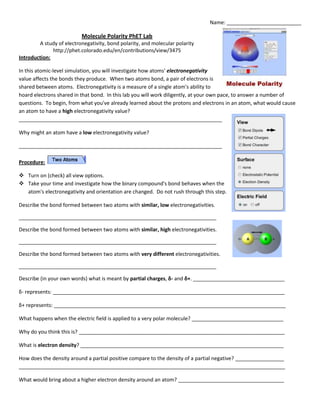
Molecular polarity phet lab
- 1. Name: __________________________ Molecule Polarity PhET Lab A study of electronegativity, bond polarity, and molecular polarity http://phet.colorado.edu/en/contributions/view/3475 Introduction: In this atomic-level simulation, you will investigate how atoms' electronegativity value affects the bonds they produce. When two atoms bond, a pair of electrons is shared between atoms. Electronegativity is a measure of a single atom's ability to hoard electrons shared in that bond. In this lab you will work diligently, at your own pace, to answer a number of questions. To begin, from what you've already learned about the protons and electrons in an atom, what would cause an atom to have a high electronegativity value? _______________________________________________________________________ Why might an atom have a low electronegativity value? _______________________________________________________________________ Procedure: Turn on (check) all view options. Take your time and investigate how the binary compound's bond behaves when the atom's electronegativity and orientation are changed. Do not rush through this step. Describe the bond formed between two atoms with similar, low electronegativities. _____________________________________________________________________ Describe the bond formed between two atoms with similar, high electronegativities. _____________________________________________________________________ Describe the bond formed between two atoms with very different electronegativities. _____________________________________________________________________ Describe (in your own words) what is meant by partial charges, δ- and δ+. ________________________________ δ- represents: _________________________________________________________________________________ δ+ represents: _________________________________________________________________________________ What happens when the electric field is applied to a very polar molecule? ________________________________ Why do you think this is? ________________________________________________________________________ What is electron density? _______________________________________________________________________ How does the density around a partial positive compare to the density of a partial negative? _________________ _____________________________________________________________________________________________ What would bring about a higher electron density around an atom? _____________________________________
- 2. A bond is characterized as ionic or covalent by comparing the differences between two atoms' electronegativities. Describe an ionic bond in terms of the atoms' electronegativity values. ___________________________________ Describe a covalent bond in terms of the atoms' electronegativity values. _________________________________ Additionally, we further separate covalent bonds into polar covalent and nonpolar covalent. What would have to be the case for a bond to be nonpolar covalent? _____________________________________________________ In this simulation realize that in addition to changing the electonegativities, you may also move individual atoms by dragging them with the mouse. Here, in addition to bond polarity (represented by the bond dipole), the entire molecule may be polar (represented by the molecular dipole). It is this molecular dipole that determines the polarity of the molecule and how it interacts with other molecules and its environment. For instance, molecules with high molecular dipoles tend to have high intermolecular forces. (Why?) BTW: The molecular dipole is found using vector addition, adding the bond dipoles together; think a tug-of-war. Take some time and adjust each of the atom's locations and electronegativity values several times. Observe how the bond dipoles (between A-B and B-C) add to produce a molecular dipole. How might a molecule with two strong bond dipoles have no molecular dipole at all? _______________________ _____________________________________________________________________________________________ How might a molecule have a very strong molecular dipole. ____________________________________________ "Like dissolves like" is a way to remember that molecules with similar molecular dipoles will tend to interact favorably and mix. For instance, water (H2O) is a polar molecule. It will mix well (dissolve) polar molecules, such as ammonia (NH3), a mixture often used in household cleaners. Both molecules possess strong molecular dipoles. A molecule such as methane (CH4) would not dissolve well into water. Why? ______________________________ Before using the simulation, complete the table below (with a √) to predict which of the following should dissolve into water. Create a Lewis-dot diagram (:Ӧ=C= Ӧ: ) for each to guide your thinking. (use a separate page) Prediction (before using the simulation) H2 N2 O2 F2 HF H2O CO2 HCN O3 NH3 BH3 BF3 CH2O CH4 CH3F CH2F2 CH3F CF4 CHCl3 √ Next, use the simulation to determine with of the species should dissolve in water. H2 N2 O2 F2 HF H2O CO2 HCN O3 NH3 BH3 BF3 CH2O CH4 CH3F CH2F2 CH3F CF4 CHCl3 √ Finally, what type of solvent would be required to dissolve nonpolar compounds? __________________________